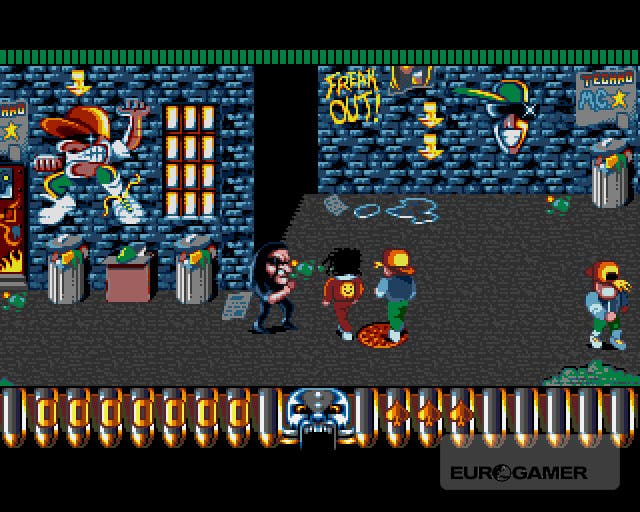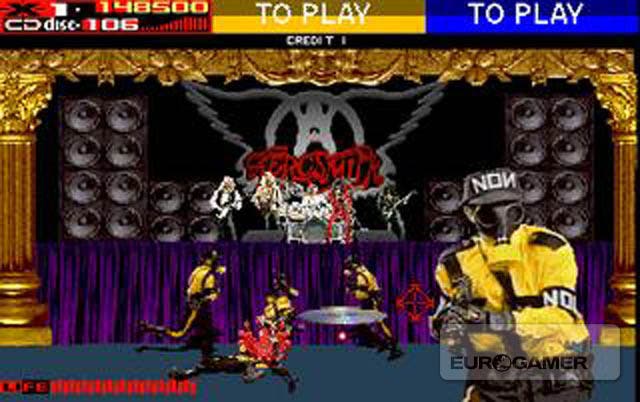Rock Star Games
The bastard union of rock 'n' roll and gaming.
Motorhead-ache
Let's fast forward several years to 1992 and the release of Motorhead on the ST and Amiga. The guys behind the game were obviously crying into their beer over the dominance of dance music in the charts, presumably leading to an alcohol-fuelled fantasy which saw rock demigod Lemmy beat some sense into a jilted generation. This fantasy quickly became a scrolling beat-'em-up in which Lemmy wipes the dance floor with ravers, country fans, karaoke singers and anyone else foolish enough to question the virtues of hard rock.
Featuring great cartoon graphics and packed with humour, Motorhead is easily the best game to be found in this feature (which isn't really saying much). How much input Lemmy had is unknown, but I can only assume that he issued a grunt of approval - particularly as his character downs bottles of whisky to top up his health.
Meanwhile, over in the States, EA was busy doing a deal with notorious rockers Motley Crue. Over the years many acts have lent their names to pinball machines, and pinball videogames have always been popular, so it stood to reason that a celebrity endorsed pinball videogame would be a winner. And so Crue Ball was released for the Mega Drive, and it wasn't half as bad as it sounds. Featuring renditions of 'classic' Motley Crue tracks such as Dr. Feelgood, Home Sweet Home and Live Wire, Crue Ball was your everyday pinball game, except with the added hairspray and skulls that came with the territory of the musical man-whores. The intention was to hit various targets on screens one and two, which opened up the third tier where the real scoring could begin. With the third screen completed, the player gained access to the volume control, and in the true spirit of rock 'n' roll, was able to crank it up to 11... although to be honest you could just turn up the volume on your TV.

In 1994 Pacific Gameworks put a proposal together for a Jaguar game that could have single-handedly changed the fortunes of the ailing machine. Had it been made, that is. The Jaguar is best remembered for the excellent Aliens Versus Predator, but had Pacific not been ignorant to the power of Aussie rockers AC/DC, the story may have been very different. Ladies and gentlemen, please be upstanding for the best game that never was - AC/DC: Defenders of Metal.
The basic premise was not too far removed from the Motorhead game. The band, collectively and as individuals, would fight their way to musical supremacy by battling the best of each musical genre, taking on representatives from disco, hip-hop, pop, jazz, and country, until they had proved themselves as the rampaging, hard-rocking, crown rulers of music. The thought of a digitised Angus Young in his schoolboy uniform versus MC Hammer and his giant pants, battling each other for world domination is almost too much to comprehend. Or maybe Brian Johnson, sporting his trademark flat cap, facing off against Bruce Springsteen with his rubbish ripped denim, swinging microphones like deadly medieval knights in a true fight for the right to ROCK is sadly something we'll never experience. They say that some of the best games are never actually made, which was surely the case when a big, fat, suited executive stamped the Defenders of Metal proposal with a huge rubber rejected stamp.
Walk that way
We all know that since the 11th September 2001 attacks the world has changed. Governments are now more alert than ever, and each ruling nation has plans for terrorist assaults including such terrible scenarios as chemical attacks, dirty bombs, hi-jacked planes and suicide bombers. But there's one frightening situation that I suspect no nation has adequately prepared for. What if aging US rockers Aerosmith were kidnapped?

Luckily, Midway approached this controversial subject in 1994 with Revolution X. This infamous arcade game introduced the New Order Nation, an organisation whose goal was to enslave 'the kids' by suppressing all forms of entertainment. Of course in 1994, when NON was looking to kidnap leading figures from the world of music, it stood to reason they'd snatch leotard-rockers Areosmith, who were having something of a resurgence at the time with their Get a Grip album. I can only imagine the kidnappers used up an entire roll of duct tape on Steven Tyler's gigantic mouth and famously groping hands.
It was up to the player then to save Aerosmith and free the world's youth by firing guns loaded with CD ammo ("Music is the weapon", see) at badly digitised sprites, all to the accompaniment of such genuine classics as Walk This Way and Toys In the Attic. That's right - Revolution X was a light-gun game, and I'm sure that the publisher, developer, coding team, cabinet maker and the band members themselves would not mind me pointing out that Revolution X is easily the worst light-gun game ever made. And instead of trying to contain this filth, Midway allowed it to seep onto the home console market.
And it's with Revolution X that the curtain falls. Other games followed, including the crazy four-player beat-'em-up Wu Tang: Taste the Pain on the PlayStation, and the tenuous FPS Kiss: Psycho Circus on the Dreamcast. And besides, Revolution X is a good place to wrap as it proves beyond a doubt that music/videogame crossovers will never, ever work. Bands should stick to what they're good at, rather than desperately trying to appeal to the kids by appearing in a badly implemented, poorly produced, embarrassing effort of a game. Play rock 'n' roll. Play videogames. But don't try and play them together.
